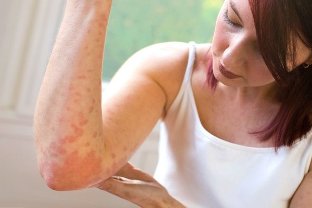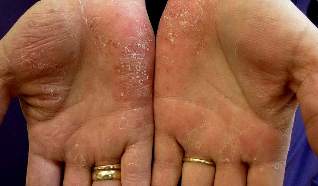Every year millions of people face skin diseases of different nature. They can be infectious and noninfectious. Most often, (completely healthy at first glance, people) are diagnosed with psoriasis. It occurs in various parts of the body may be of varying intensity. It bothers patients and their surroundings, because people are afraid of infection. Take a look at what psoriasis is, its causes, symptoms and treatment methods.

What is psoriasis
Psoriasis on the skin disease of a chronic nature, cannot be transmitted from person to person. Previously, this diagnosis was considered a nutritional inflammation of the skin, but today it is called psoriatic disease, due to the fact that it has a systemic nature, that is occurring as a result of failure in the endocrine, immune, and nervous system.
The mechanism of development of psoriasis on the body
Not to notice the nidus is not possible, because in that part of the body appear burning, itchy feeling, redness and exfoliating the skin. Every person faced with a diagnosis, begins to feel discomfort when dealing with people, because the disease disfigures the affected area of the body.
The mechanism of development is that skin cells die after 4-5 days, but not disappear, and formed into papules and flaked off, causing inflammation. The disease is not transmitted by touch, so epidemics do not happen. The occurrence of psoriasis associated with hyperactivity of immune T-lymphocytes.
Usually the disease appears in genetically predisposed to it people:
- If one parent has a predisposition to the disease, the probability of occurrence of the diagnosis of the child – 25%.
- If 2 parents – 65%.
Psoriasis can occur at any age, even if in childhood there were no signs of its presence. The trigger may be treatment with antibiotics, alcohol, stress, skin trauma, vitamin deficiency.
Causes, symptoms and treatment of psoriasis
Though, the disease – psoriasis affects people for many centuries, its source is still not installed. The disease can affect anyone, even those without a predisposition to the development of pathology.
Doctors put forward such a theory concerning the causes of psoriasis:
- Virus.
- Immune.
- Infectious.
- Genetic.
- Caused by metabolic disorders.
Each of these causes can trigger pathological focus, localizable in any area of the body: the head, arms (particularly elbows), legs, and psoriasis appears under the chest and abdomen.

Why a person has psoriasis: virus theory
Scientists in search of the causes of psoriasis found changes in the peripheral lymph nodes, a sign of viral forms of the disease.
Doctors believe that retroviruses, transmitted by genetic means, are the reasons of psoriasis, but to prove it, you need to:
- To highlight the retrovirus and identify it.
- To identify habitat.
- Carefully examine that beyond the power of modern medicine.
Retroviruses possess the ability to change the genetic structure through DNA synthesis and the formation of "falsum progressio". This factor is still being studied by doctors, but by blood transfusion from a patient with psoriasis to a healthy, never mentioned the disease the second that puts this theory in doubt.
Immune dysfunction
Immune sphere affect many structures of the body, but observed that the appearance sinusitis, tonsillitis, etc. autoimmune diseases, pathological lesions aggravated.
During the initial onset of psoriasis, doctors believe that is the primary source of the autoimmune aggression.
There have been many diagnostic procedures, examining patients with the occurrence of de microabscesses of Munro, appeared in the result of abnormalities in:
- Immunoglobulins.
- Antibodies.
- Immune complexes.
Inflammation of the skin provoked by psoriasis increases the sensitivity of the epidermis, especially in areas struck by chemical or physical means. Then, there is increasing size of a rash and irritation. In studies, experts have identified antibodies to antigenic components are the antigens that are not present in people without the predisposition to pathology.

Infectious theory
It is believed that the causes of psoriasis are directly linked to the infection. The aggravation of the pathology often fix the people trapped in the hospital, despite the fact that pathogenic fungi and micro-organisms detected. According to the scientists, psoriasis on the background of the infection appears as a result of arrival of impulses in the autonomic and endocrine systems, which causes changes to the structures of the body on the basis of the immune dysfunction.
Also, there is allergo-infectious theory, characterized by an allergic reaction to viruses, microorganisms and their toxic secretions, but officially, this theory is not yet proven.
Genetic theory
This theory suggests that psoriasis is passed from parents to children and from close and distant relatives.
This is because the majority of people who applied to skin-the vein clinic with psoriasis, I have this disease has a history of close 3-5 generations, but to call the disease is strictly genetic is impossible, because it occurs against a background of complex disorders:
- Changes of enzyme, lipid, carbohydrate and protein metabolism.
- Immune, endocrine, autonomic dysfunction.
- Viral and infectious diseases.
Abnormalities in the metabolism
Disturbances in the metabolism, are a source of many diseases.
In psoriasis studies show
- High cholesterol
- Temperature below normal.
In this case, the experts klassificeret psoriasis as cholesteric diathesis, because improper lipid metabolism cause the skin keratinization.
Also, the clinical picture the patient may have the following characteristics:
- Disorders of vitamin metabolism group B6/12, And, C. the amount of vitamin C in the body more than.
- A lack or excess of zinc, copper, iron.
These factors reduce the adaptive capacity of the person and contribute to the onset of diabetes, which often accompanies psoriasis.

Where else does the disease psoriasis (additional reasons):
- Stress.
- Acclimatization.
- Vaccination.
- Allergies.
- Women's hormonal disorders.
- Burns, injuries, bug bites.
- Medications and alcohol.
- Hypothermia.
- The abuse of certain products.
- Food poisoning.
Psoriasis can appear in any person, regardless of age and sex, but the sooner he appears, the more the patient's body deals damage and changes the quality of his life.
The first signs of psoriasis
Initially, the disease manifests itself in the form of a small, peeling-prone papules, localized in the area previously affected area of skin. At the initial stage psoriasis can have a gradual or sudden character development. Further, that appears on the skin pinkish nodules are strongly itch, burn and are starting to become covered in a rash or flaky crust. Patient strive to comb the pathological lesions as it brings relief, but further traumatize the skin. Combing the psoriasis is a risk that the disease spreads to nearby tissues, so when the first symptoms, you should immediately consult a doctor.
The first signs of psoriasis are a rash on these parts of the body:
- Inguinal folds.
- Head.
- Shin.
- Lower back.
- The stomach (under the breast).
- The nails/fingers.
- Arms, legs (knees, elbows, palms, soles).
To facilitate the diagnosis of psoriasis, experts have divided the disease into several forms with their own symptoms and individual localization. For example:
- The symptoms of psoriasis plaque forms, characterized by depilatus red papules having clear borders. They are usually located in the head, waist, elbows and knees.
- When you teardrop psoriasis, the symptoms are completely different. In the affected area there are many small spots or pustules, when pressed, they allocated a transparent liquid. They usually occur on the back side of the palms and feet.
It is a mild forms of psoriasis. Their development does not cause fever, joint aches, chills. However, you need to treat any form of disease, because if you do not resort to treatment with the first signs of psoriasis can spread to joints, nails and mucous membranes.
To learn how the disease in the initial stages, see photo signa developing on the skin psoriasis.

Typical signs of psoriatic arthritis
Psoriatic arthritis refers to severe forms of psoriasis. If the disease affects the joints, which leads to their deformation and further to the partial/full dysfunction. At the initial stage, the disease is localized in the feet and hands, and then transferred to the segments of the vertebral column and major joints. Then the joints increase in volume, start to hurt.
On examination, the doctor pays special attention to the following factors:
- Is there a genetic predisposition to psoriasis.
- Swelling of the joints.
- Pain syndrome when walking, touch the items.
- The limitation of mobility.
- Stiffness in the joints (day and morning).
Also, the specialist will prescribe the tests. First he needs to make sure that the pain in the joints is caused by psoriasis. For this the patient must take a test for rheumatoid factor. If the result is negative, so the doctor will put a diagnosis of psoriatic arthritis.
The first signs of nail psoriasis
Initial signs of the nail plate with psoriasis the identical fungus. Then around the perimeter of the nail, you notice a depressed point, or longitudinal grooves. They can appear on 1 nail or all at once, but the beginning of change is fixed at the edge of the nail plate.
In the absence of treatment disease:
- Moving to the root.
- The nail becomes inflamed, thickened, dull.
- Around the nail is formed by the red border of the skin.
This is the risk that in the result of the nail plate may even flake off from the skin or become similar to a bird's claw, because the disease affects not only the skin, but the nerve endings.

The treatment of psoriasis
Cure psoriasis completely impossible, as the disease assumes a chronic character. The most that doctors can do is prescribe medication that creates a strong remission of the disease.
Medicinally prescribe medicines local destination. They increase the infiltration of the skin, reduce flaking and eliminate the inflammatory process, entailing a itchy feeling.
Such drugs include ointments and creams containing:
- Dithranol.
- Salicylic acid.
- Sulphur.
- Urea.
Also, experts prescribe the local glucocorticoids and lotions that are suitable for the treatment of the scalp.
The purpose of therapy is influenced by many factors:
- The age of the patient.
- The primary manifestation of the disease or the aggravation.
- As the inflammation progresses.
- Where is localized the lesion.
- The duration of the disease.
- In what form is manifested, etc.
An appointment specialist will examine the patient, collect medical history and prescribe a biopsy of the affected area.
After receiving the results, will use such methods of treatment.

|
At an advanced stage hormonal anti-inflammatory: During exacerbation and severe inflammation, fluorinated media: |
These medications in 70% of cases eliminate inflammation and rash, within 2 weeks of treatment of psoriasis. |
|
Glucocorticoids negalogenizirovannam type: |
Tools are widely demanded for the treatment of pensioners and children, because the de-composition of fluorine and chlorine reduces the likelihood of allergic reactions. |
|
Creams and ointments on the basis of dithranol: |
Have antiproliferative and anti-inflammatory effect. Often cause allergies, in the form of itching and local swelling. They are administered in increasing doses for short-term treatment. |
In addition to these methods there are other, equally effective, but they should choose solely the doctor. Not correctly selected therapy is able to aggravate the patient's condition and cause a progressive inflammatory process on the background of allergic reactions, so do not experiment with drugs. In addition, they should continuously change, because the body gets used to the meds and the therapy efficiency is gradually reduced.























